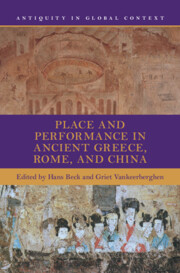Book contents
- Place and Performance in Ancient Greece, Rome, and China
- Antiquity in Global Context
- Place and Performance in Ancient Greece, Rome, and China
- Copyright page
- Contents
- Figures
- Tables
- Contributors
- Series Editors’ Preface
- Editors’ Preface
- Introduction
- Part I Crafting Space and Place
- Chapter 1 Theories of Place Across Time and Space
- Chapter 2 Local Administration, History, and Geography in the Han and Roman Empires
- Part II Performances of Power
- Part III Urban Places
- Part IV Fringe Places and Endpoints
- Index
- References
Chapter 2 - Local Administration, History, and Geography in the Han and Roman Empires
Ban Gu’s “Dili zhi” and Strabo’s Geographika
from Part I - Crafting Space and Place
Published online by Cambridge University Press: 28 November 2024
- Place and Performance in Ancient Greece, Rome, and China
- Antiquity in Global Context
- Place and Performance in Ancient Greece, Rome, and China
- Copyright page
- Contents
- Figures
- Tables
- Contributors
- Series Editors’ Preface
- Editors’ Preface
- Introduction
- Part I Crafting Space and Place
- Chapter 1 Theories of Place Across Time and Space
- Chapter 2 Local Administration, History, and Geography in the Han and Roman Empires
- Part II Performances of Power
- Part III Urban Places
- Part IV Fringe Places and Endpoints
- Index
- References
Summary
The beginnings of geographical writings in Graeco-Roman and Han-Chinese culture were subject to divergent perspectives on the natural environment. While ancient Chinese views were typically land-based, the Mediterranean Sea invited a maritime perspective. From the works of early Greek traveling writers, the exercise of geographia (literally ‘description of the earth’) was therefore inspired by principles and practices of circumnavigation, including the detailing of distances and orientation toward topographical features. In China, on the contrary, under the heading of xing fa, an evolving body of geographical manuals focused foremost on shapes and forms, including those of humans, objects, or provinces. Luke Habberstad undertakes the comparative analysis of two authors whose works are commonly considered emblematic of the genre of geographical literature in both civilizations: Strabo of Amaseia (first century BCE/CE), author of an influential Geography, and Ban Gu (first century CE), whose “Treatise on Geography” (“dili zhi”) became an influential precedent for imperial histories compiled in later dynasties. Habberstad’s discussion of authorship, text, and context makes it obvious that Strabo and Ban Gu differed widely in structure and focus. What united their perspectives, however, is that they were situated at analogous historical moments in the trajectory of their respective civilizations, namely, unprecedented highpoints of geographical extent and administrative organization. Literary encounters with space were thus intimately intertwined with ideas about cultural advancement. Expanding on this observation, Habberstad demonstrates that ancient geography, as encapsulated in the works of Strabo and Ban Gu, was not primarily and certainly not exclusively concerned with natural phenomena, but resonated mostly with the imperial milieus and their performative capacities to administer the vast expanse of empire.
Keywords
- Type
- Chapter
- Information
- Place and Performance in Ancient Greece, Rome, and China , pp. 59 - 86Publisher: Cambridge University PressPrint publication year: 2024

